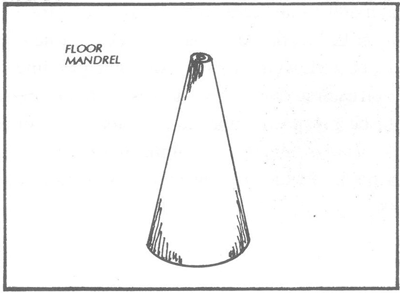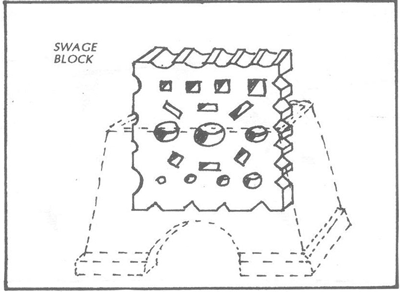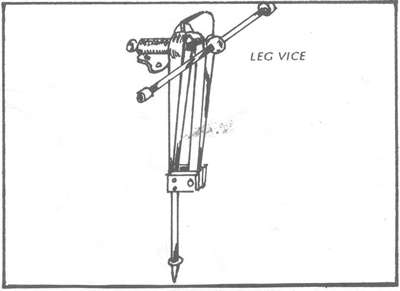THE HEARTH
To work iron and steel successfully, we need to be able to heat the metal rapidly over a temperature range from ambient to 1 300° or 1 500°C. Therefore, our first consideration is the hearth containing the fire.
Many designs of hearth have been developed, each with its own characteristics. A side-blast hearth with a water-cooled tuyere (blast pipe) is preferable. Models are available with the blast of air supplied from below, utilizing a cast-iron fire pot or fire base. Good work can be carried out with either type. The hearth can be made of steel or brick.
To attain the high temperatures required, the air blast increases the rate of oxidation of the fuel and thus the temperature. Air blast can be supplied by hand-operated bellows, a hand-operated fan or an electrically powered fan or air compressor. Some form of control is needed to regulate the amount of air fed to the fire. Electrically powered fans may be fitted with a variable-speed motor and a speed regulator, a simple slide valve, a butterfly valve or a rotating plug cock. Hand-powered fans or bellows are, of course, controlled by the speed of turning or pumping.
Figure 1 illustrates a bottom-blast hearth. This type of hearth can be used for light work and, being small, is readily portable. It can be fitted with a hood and chimney if desired. Any of the previously mentioned sources of air blast can be used. Ash and clinker from the combustion of fuel can be emptied by opening the ash vent, which is normally held in place by a counterweight.
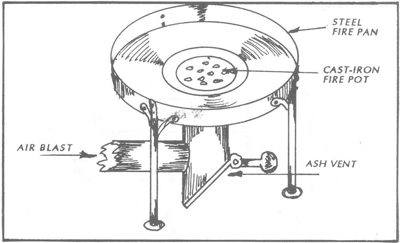
The chief disadvantages of this type are the difficulty in controlling the size of the fire and the tendency of the cast-iron fire pot and centre disc to crack under the influence of heat.
The advantages are that it is cheap to buy or make and simple to operate and service.
To cover the full range of a blacksmith's work and for prolonged periods of work, a more elaborate hearth is desirable (Fig. 2). A side-blast hearth with a water-cooled tuyere fills all requirements. Such a hearth can be made of steel or built of common brick. It should be of a height comfortable for the smith, usually about one metre or slightly more from the ground to the top lip of the hearth. A hood and chimney are usually fitted and are highly desirable additions. Air blast is again provided by any of the means previously mentioned, but an electrically powered fan is probably the best. This should be fitted with a speed control or a simple valve (usually a slide valve) to regulate the air fed to the fire.
The blast pipe should be water-cooled. This is usually accomplished by an open tank allowing water to circulate around the blast pipe. Extremely useful is a water tank for quenching tools and workpieces. The disadvantages of this type of hearth are that it is comparatively expensive, more complex than the bottom-blast type and requires more regular servicing.

THE ANVIL
To work iron and steel a good anvil is essential. It should be as heavy as possible (at least 80 kg) and have a hardened and ground face. Several patterns are available, the more common being the London pattern, the European pattern and the farriers' (horseshoeing) anvil. Good work can be carried out on any of these, but the London pattern is most versatile (Figs 3, 4 and 5).
A suitable stand can be a large block of wood such as a section of a tree trunk firmly fixed in the ground, one made of heavy angle iron or a commercially made one of cast iron.
The correct working height for an anvil will depend on the height of the blacksmith. The anvil face should be knuckle-height when the smith stands by its side.
The anvil face should be highly polished and free of tool and hammer marks. It must be kept clean and free of water and metal scale both for safety and for a good finish on the work. Any sharp edges on a new anvil should be removed by filing or light grinding. The edges on each side of the face nearest to the cutting table should be given a distinct radius, about 6 mm for a length of approximately 50 mm. Sharp edges create stress points in the forging and they in turn lead to cracks.
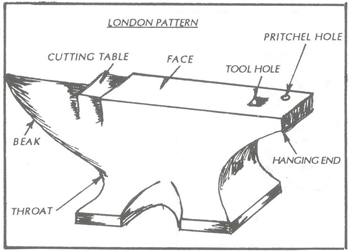
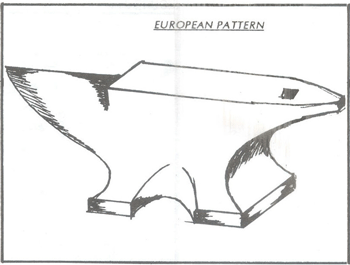
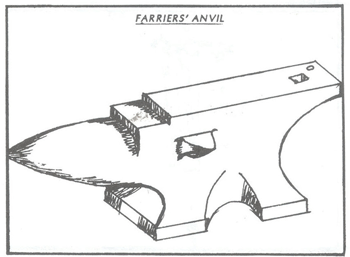
FLOOR MANDREL
For many jobs a floor mandrel is useful. This is a hollow cast-iron cone about 1.25 m in height. It is used for rounding up small tyres, rings and hoops (Fig. 6).
SWAGE BLOCK
For heavy swaging, forming, bending and many other similar jobs, a swage block is a useful piece of equipment. It is made of cast iron and can vary in weight from a few kilograms to 200 or more. There are a number of designs, with various swage depressions on the outer edges as well as holes of various shapes and sizes running through the thickness of the block (Fig. 7).
THE VICE
A stout bench with a heavy vice attached completes basic blacksmithing equipment. The vice most suitable to withstand heavy work is the leg vice (Fig. 8). It is made in various sizes, but one with jaws about 150 mm wide is a reasonable size for the average workshop.
